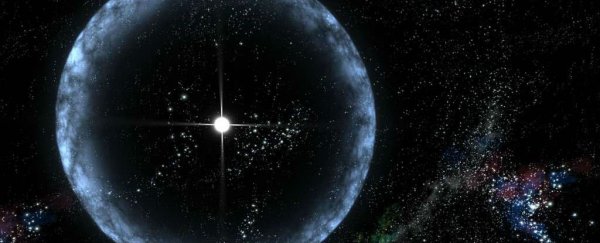Fast radio bursts (FRBs) are arguably the weirdest phenomena in our Universe right now. They're some of the most explosive signals ever detected in space, generating as much energy as 500 million Suns in mere milliseconds, but scientists have been struggling to explain them.
Now, astronomers have pinpointed the exact location of one of the most famous FRBs, and it provides even more evidence that these mysterious signals result from young neutron stars - the densest objects in the known universe. But there's a catch - there might now be two types of FRB, and this only explains one of them.
Fast radio bursts are such a confounding phenomenon for scientists to study, because it's like trying to trace the trajectory of a needle in a Universe-sized haystack that disappears with a few thousandths of a second.
Due to their incredibly fleeting appearance, astronomers have only ever detected 23 of them, despite estimates that there are around 2,000 FRBs firing across the Universe every single day.
But one very special fast radio burst, called FRB 121102, finally gave us a fighting chance, because it's come to be known as our very first 'repeating FRB'.
Some 30 signals have emanated from the same place in the Universe, which means astronomers can train their telescopes in on that spot, instead of randomly scouring deep space in the hopes of catching a blip.
A few months ago, researchers from McGill University in Canada announced that they'd used the Very Large Array (VLA) telescope in New Mexico to narrow down the source of FRB 121102's repeating signals - a faint dwarf galaxy, more than 3 billion light-years from Earth.
As we reported as the time, before the discovery of these repeating FRBs, the leading hypothesis was that the bursts were coming from inside our Milky Way, caused by a one-off cataclysmic collision between two neutron stars - the same process that forms a black hole.
Now that we know FRB 121102 is coming from beyond the Milky Way galaxy, scientists have had to rethink their origins, and the McGill team favours neutron stars as the most likely candidate.
Neutron stars are incredibly dense objects that form after a star collapses, and emit regular radio pulses as they spin.
A highly magnetic type of neutron star, called a magnetar, is surrounded by material ejected by a supernova explosion or pulsar, which could explain the repeating bursts of energy.
Now, thanks to new images from the Hubble Space Telescope and the 8.2-metre Subaru Telescope in Hawaii, the McGill researchers and a separate team from Tohoku University in Japan have honed in on the source of FRB 121102 even further - to a giant stellar nursery near the centre of the distant dwarf galaxy.
"The Hubble and Subaru images show that the star-forming complex lies on the small galaxy's outskirts," Ken Croswell reports for New Scientist.
"Hubble's handiwork puts the galaxy's visible diameter at about 20,000 light-years, one-sixth that of the Milky Way. The stellar nursery is 6,200 light years from the galaxy's centre and spans 4,400 light years, far larger than any known in the Milky Way."
We should point out that both the McGill and Tohoku University team are yet to have their results peer-reviewed, so some of the details could be subject to change with independent scrutiny.
But they say that pinpointing the source of FRB 121102's repeated signals to this star-birthing region has strengthened the case for young neutron stars being the cause, as they're exactly the kind of phenomenon that could appear there.
What's interesting now is that just as we're narrowing in on an explanation for FRB 121102, we might be getting further away from understanding all the other FRBs out there that don't repeat.
While Jonathan Katz from Washington University in St Louis, who wasn't involved in either study, told New Scientist that it might be possible to link all FRBs to young neutron stars, another independent expert, Dale Frail from the US National Radio Astronomy Observatory says that might be pushing it.
"I would be reluctant to draw such broad conclusions based on a sample of one," he says.
The hunt is still on, but with this new Australian telescope detecting its first fast radio burst within just four days of operation, hopefully we won't have to wait too long for that sample size to increase.
The two preliminary papers have been published on pre-print website arxiv.org, here and here.
